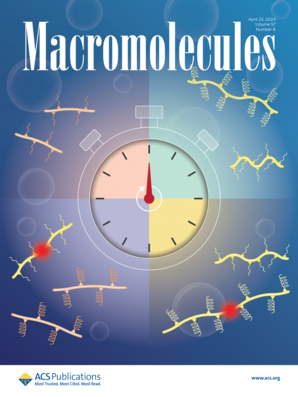热力学和动力学控制下网络设计参数对Diels-Alder共混物形态演变的影响
IF 5.1
1区 化学
Q1 POLYMER SCIENCE
引用次数: 0
摘要
可逆聚合物网络共混物利用了不混相聚合物骨架的优势特性。先前的研究表明,通过可逆Diels-Alder反应固化的亲水性聚环氧丙烷(PPO)和疏水性聚二甲基硅氧烷(PDMS)共混物的相形态取决于两种聚合物的质量比和用于可逆网络聚合的马来酰亚胺与呋喃的比例。本文研究了可逆Diels-Alder反应与相分离动力学和热力学之间的竞争,以控制相的形成。将一个摩尔质量为4546 g mol-1的呋喃功能化PPO与具有不同摩尔质量、聚合物质量比和化学计量比的呋喃功能化PDMS共混。当PDMS和PPO的最大摩尔质量为4961 g mol-1时,它们会迅速分离成不同的层,分别形成阻隔水和氧气的屏障。层的厚度、形态和组成取决于共混物的组成。当PDMS的摩尔质量较低时,呋喃端基的化学性质变得更加明显,这增加了两种聚合物的相容性,降低了相分离的热力学驱动力。此外,呋喃和马来酰亚胺基团浓度的增加增加了diols - alder反应速率,并导致更多的交联网络共混物。通过合理组合网络设计参数,掌握共混物的热力学与网络形成和相分离动力学之间的相互作用,最终形成从动力学捕获的均匀微观结构到几乎完全相分离的共混物形态。最后,以溶剂萃取时间作为湿法混合工艺的工艺参数。在一周的缓慢蒸发过程中,通过相同的Diels-Alder化学反应,将两种不混溶的聚合物分离成具有完美界面键合的独立层,达到接近平衡。这些因素的操纵使Diels-Alder网络的发展具有广泛的性质,适用于各种各样的应用。在PPO含量较高和PDMS摩尔质量最高的情况下,可以实现最快和最有效的自主愈合,而在交联密度最高的情况下,可以获得最佳的水和氧屏障。本文章由计算机程序翻译,如有差异,请以英文原文为准。

Influence of Network Design Parameters on the Morphology Evolution in Diels–Alder Blends via Thermodynamics and Kinetics Control
Reversible polymer network blends leverage the advantageous properties of immiscible polymer backbones. Previous work showed that the phase morphology of blends of a hydrophilic poly(propylene oxide) (PPO) and hydrophobic polydimethylsiloxane (PDMS) cured by the reversible Diels–Alder reaction depends on the mass ratio of the two polymers and the maleimide-to-furan ratio used for the reversible network polymerization. This work studies the competition between the reversible Diels–Alder reaction and the phase separation kinetics and thermodynamics to control the phase formation. A furan-functionalized PPO with a molar mass of 4546 g mol–1 was blended with furan-functionalized PDMS with different molar masses, mass ratios of the polymers, and stoichiometric ratios. At the highest molar mass of 4961 g mol–1, the PDMS and PPO separated quickly into separate layers, creating a barrier against both water and oxygen, respectively. The thickness, morphology, and composition of the layers depend on the composition of the blend. At a lower molar mass of the PDMS, the chemistry of the furan end groups becomes more pronounced, which increases the compatibility of the two polymers, reducing the thermodynamic driving force for phase separation. In addition, the increased concentration of furan and maleimide groups increases the Diels–Alder reaction rates and leads to more cross-linked network blends. Mastering the interplay between the thermodynamics of the blends and the kinetics of the network formation and phase separation by judicious combinations of the network design parameters leads to final blend morphologies ranging from kinetically trapped uniform microstructures to almost completely phase-segregated morphologies. Finally, the solvent extraction time was used as a process parameter of the wet blending process. Slow evaporation of the solvent over the course of 1 week resulted in a near-equilibrium separation of the two immiscible polymers into separate layers with perfect interfacial bonding by the same Diels–Alder chemistry. Manipulation of these factors enables the development of Diels–Alder network blends with a wide range of properties that are suitable for a wide variety of applications. The fastest and most efficient autonomous healing is achieved at higher PPO contents and for the highest PDMS molar masses, while the best barriers against water and oxygen are obtained at the highest cross-link densities.
求助全文
通过发布文献求助,成功后即可免费获取论文全文。
去求助
来源期刊

Macromolecules
工程技术-高分子科学
CiteScore
9.30
自引率
16.40%
发文量
942
审稿时长
2 months
期刊介绍:
Macromolecules publishes original, fundamental, and impactful research on all aspects of polymer science. Topics of interest include synthesis (e.g., controlled polymerizations, polymerization catalysis, post polymerization modification, new monomer structures and polymer architectures, and polymerization mechanisms/kinetics analysis); phase behavior, thermodynamics, dynamic, and ordering/disordering phenomena (e.g., self-assembly, gelation, crystallization, solution/melt/solid-state characteristics); structure and properties (e.g., mechanical and rheological properties, surface/interfacial characteristics, electronic and transport properties); new state of the art characterization (e.g., spectroscopy, scattering, microscopy, rheology), simulation (e.g., Monte Carlo, molecular dynamics, multi-scale/coarse-grained modeling), and theoretical methods. Renewable/sustainable polymers, polymer networks, responsive polymers, electro-, magneto- and opto-active macromolecules, inorganic polymers, charge-transporting polymers (ion-containing, semiconducting, and conducting), nanostructured polymers, and polymer composites are also of interest. Typical papers published in Macromolecules showcase important and innovative concepts, experimental methods/observations, and theoretical/computational approaches that demonstrate a fundamental advance in the understanding of polymers.
 求助内容:
求助内容: 应助结果提醒方式:
应助结果提醒方式:


